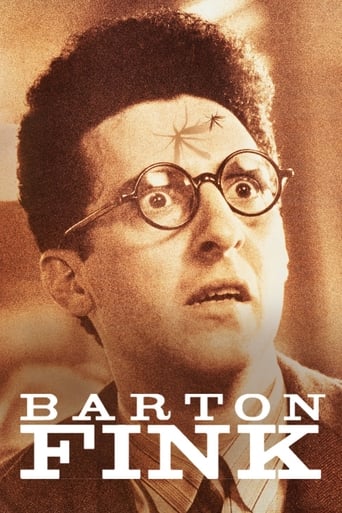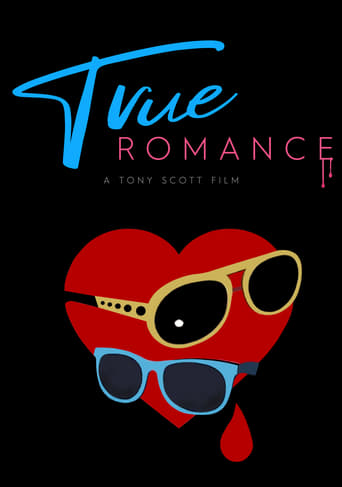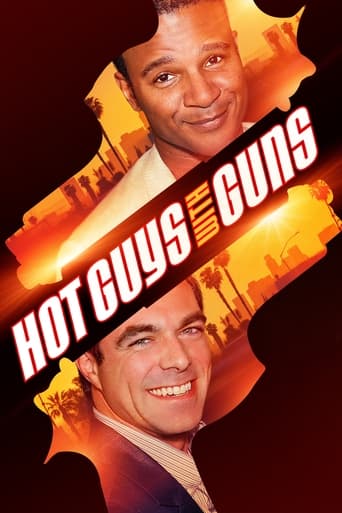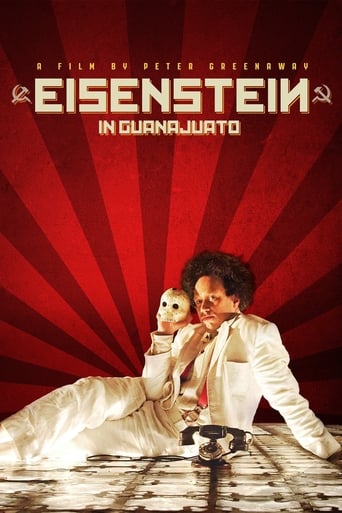
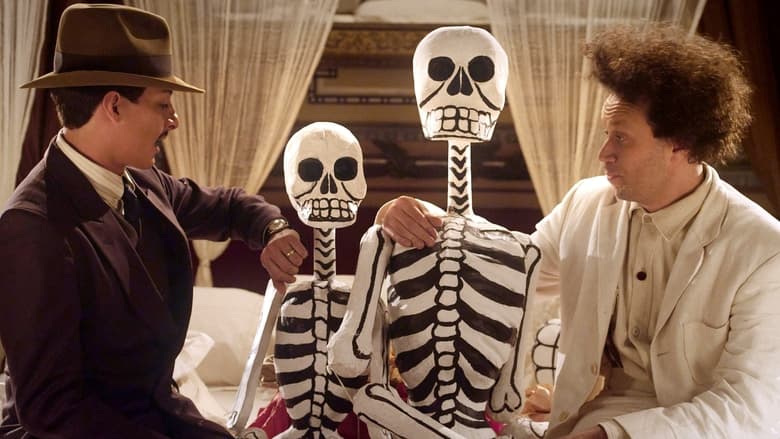
Eisenstein in Guanajuato (2015)
In 1931, following the success of the film Battleship Potemkin, Soviet filmmaker Sergei Eisenstein travels to the city of Guanajuato, Mexico, to shoot a new film. Freshly rejected by Hollywood, Eisenstein soon falls under Mexico’s spell. Chaperoned by his guide Palomino Cañedo, the director opens up to his suppressed fears as he embraces a new world of sensual pleasures and possibilities that will shape the future of his art.
Watch Trailer
Cast
Similar titles



Reviews
Just perfect...
Fantastic!
There are better movies of two hours length. I loved the actress'performance.
It was OK. I don't see why everyone loves it so much. It wasn't very smart or deep or well-directed.
As the title indicates, this is a biopic inspired by the Mexican days of Soviet Union cinema vanguard Sergei Eisenstein (1898-1948), after his sortie into Hollywood proved to be futile, in 1930, he was assigned to make the ambitious but ultimately problematic project QUE VIVA MEXICO in Mexico (the whole ordeal is worthy of its own screen re-enactment), which Eisenstein would later relinquishes, a relatively intact version would only be released posthumously in 1979. No one would expect Peter Greenaway's treatment to be strictly reverent, although now in his seventies, Greenaway has no hesitation of venturing into the prurient facet of Eisenstein's idiosyncrasy and abandon, preponderantly, the film is a two-hander between Sergei (Bäck) and his Mexican guide Palomino Cañedo (Alberti), to whom Sergei claims to lose his virginity. Sergei's homosexual initiation is explicitly explored in the palatial hotel room he stays, on that vast bed, the sex temple he shares with Palomino, and coins the first ten days in Guanajuato as "Ten Days that shook Eisenstein", a wordplay to his revolutionary pièce-de-résistence OCTOBER: TEN DAYS THAT SHOOK THE WORLD (1928). Greenaway delights in magnifying Eisenstein's blunt self-reflection and directorial frustration (although it is mostly an interior piece that largely overlooks the filmmaker's onerous field work, excluding a visit to the Mummies of Guanajuato and the institution of the Day of the Dead celebration) through his larger-than-life approach which constitutes operatic ways of utterance, info-dumping sleight-of-hand where real-life footage is rapidly juxtaposed to counterpoint the references in a triptych split-screen, and majestic, but noticeably digitally airbrushed and light-inflected scenography, being put into great use in the flourishes of 360 degree twirling shots and seamlessly edited faux-long shots, etc., all is impressive on a grandiose scale, but also appreciably betrays an overreaching effort to reassure us that he is still at the top of his game.Under the spotlight is Finnish actor Elmer Bäck's madcap impersonation of a ludic, unprepossessing Eisenstein, sporting a fuzzy, bouffant hairdo à la Einstein, and gives his all to Greenaway's undue caprices, which on the whole leaves the impression that Eisenstein is more hysterical than sympathetic, a clownish figure whose brilliance is very much elusive to moderately stunned audience, a typical case of miscast should be noted. Luis Alberti, by comparison, comes off less scathed owing to his more natural and unaffected "stud" role in the play. By and large, Greenaway's self-reflexive, symphonically flamboyant opus can be construed as a nonconformist filmmaker's knowing salute to a free-spirited genius who constantly clashes with his times and whose legacy should be incessantly exhumed to meet new light and fresh air, and knock dead any number of spectators.
Peter Greenaway's ambitions and talent are gargantuan, and his achievements, films such as Prospero's Books and The Cook, the Thief, His Wife & Her Lover, are mighty. Eisenstein in Guanajuato, which chronicles 10 days in the life of Sergei Eisenstein, is not a masterpiece, but is unique in its visual techniques and its inclusion of explicit sex (and anal sex at that!) that make it stand out among biographical films. It would have been helpful to have read a biography of Eisenstain before seeing the movie, and to have recently viewed 10 Days that Shook the World and The Battleship Potemkin and Que Viva Mexico. Nevertheless, I was thrilled by the cinematography which used techniques that I have never seen used in quite the way they are used here. For example, scenes shift quickly and often from B&W to color, and sometimes use both B&W and color in the same frame. There is one amazing scene that seems to take place at a street corner, but gradually the building behind Sergei straightens out and reveals itself to be the straight facade of a mid-block building. Every reference to an Eisenstein movie is accompanied by a shot of that actual movie. Every name dropped by the characters is accompanied by a photo of the actual person whose name was dropped. It helps in understanding the movie.The most thrilling thing about the movie, for me, is the inclusion of a rather explicit gay sex scene. It is Sergei's first time having sex, and he seduced by a very handsome young man, his handler and interpreter, who joyously teaches Sergei about the Mexican siesta, and has Sergei undress. Sergei is quite uncomfortable about his body (the actor playing him is rather ungainly, like Sergei was). Sergei does not think that anyone would want to have sex with him, no man, no woman. The handler assures Sergei that he is wrong, and proceeds, graphically, and erotically, to enter the Eisenstein anus. I rarely get aroused by non- porn movies, but this scene is one that I think about often, and fondly. The notion that an unsexy man can been seen as sexy and can become sexual, is one that I appreciate. And so, Viva Greenaway!
Peter Greenaway's career is beyond any ambitions of commercial success - his most successful (audience-wise) movies were made in the 80s. Even then the combination of colors and music, architecture (he is an architect by formation) and composition, his obsessions for sex and death and his bluntness in approaching them were much out of the beaten track. For the last two decades his projects became more and more exploratory, with the moving images being only one of the tools in combinations of multi-disciplinary explorations and experiments that brought together almost every artistic discipline that was invented. Eisenstein in Guanajuato can be seen almost as a return to the more conventional tools of film making. It has a story, and it has a hero and it has a theme, one of these themes film makers love to bring to screen, maybe the ultimate film theme - film making! If you listen to what Peter Greenaway has to tell about his film (and he speaks a lot as he promotes the film in the international festival tour) Eisentein in Guanajuato is before all a homage to one of the greatest directors in the history of cinema who was Sergei Eisenstein. It also is a social and political commentary, as it deals with what was probably the most exuberant, liberal and care-free period in the life of the screen director of the Soviet Revolution, and also with the sexual orientation of Eisenstein which was kind of a well known secret in his biography, tolerated by the Soviet authorities but maybe also a tool of blackmail by the KGB. The period spent by Eisenstein in Mexico while shooting material never gathered and edited for a film about the country and its revolutions may have been the happiest time in the life of the director already famous for Potemkin and October. It allowed him not only a unique encounter with a culture that was so different from some aspects yet so close from other compared with the Russian culture he knew from home, but also an encounter with himself, with his own demons, his self-denied homosexuality, his tendency to the luxury and the decadence of the bourgeois life, so different from the austerity he left in the Soviet Russia and to which he was condemned to return.There is almost nothing in this film about Eisenstein's film making. At no point does he shout 'Camera!' or 'Action!' - at some moment he even refuses to do so. Peter Greenaway does not try to expose any secrets of the film making art of Eisenstein, but rather deals with the surrounding context that made his films possible. Finnish actor Elmer Bäck brings on screen an Eisenstein who hides his doubts behind exuberance, and his fears behinds carelessness, who is sure of his artistic genius but unaware about his personal charisma. Mexican actor Luis Alberti builds a fine counterpoint to Eisenstein's character and a credible gay love interest. The camera work does not try to replicate anything that Eisenstein has done on screen, but rather quotes and incorporates fragments of Eisentein's movies with the visual commentaries of Greenaway. I read some critical opinions about viewers 'getting tired' by the too intense camera work - I do not agree with them. When what you see on screen is expressive and interesting you cannot get tired, as one does not get tired of seeing more masterpieces in an art museum, or of listening to fine opera or classical music. Sets are as exuberant and as complex as an architect mind like Greenaway's can conceive. Overall Eisenstein in Guanajuato was for me a very satisfying and surprisingly entertaining experience.
EISENSTEIN IN GUANAJUATO is elder British auteur Greenaway's extravagant view of the famous Russian film pioneer he claims to admire immensely. The World Premiere presented at the 2015 Berlin Film Festival was an outrageously colorful ball buster, much better than expected after numerous previous Greenaway fiascos seen over the years ~ In fact, a glorious raucous Wakeup Call in the wake of a string of big name festival soporifics earlier in the week. The film bursts forth immediately with numerous three-way split screens bulging with highly informative and educational archival footage~~ almost too many messages to absorb at a single sitting.Most outrageous of all, we see the revered cinema Grandmaster Eisenstein presented In unabashed full frontal nude glory as a gloating Fag (extinct word for "gay") --receiving rectal penis injection from handsome Mexican producer and new found Latin lover (Luis Alberti) who introduces the austere Russian filmmaker to the pleasures of alternative sexual orientation. Presumably about Eisenstein's trip to Mexico in 1931 to make his legendary lost film which was later pieced together from existing fragments by others -- his grandiose epic collage "QUE VIVA MEJICO!". Finnish born Actor Elmer Bäck (b. 1981) is no dead ringer for the real Eisenstein but the wild wiry genius hairdo serves to identify the character. This is actually more about the fun he had there than the making of the famous movie -- thought to be lost for many years -- which is a story in itself. Just remember that Guanajuato is a city in Mexico, not to be confused with GUANTÀNAMO, the infamous CIA water-boarding school in Cuba. Bring along your Mexican jumping beans and an open mind. Not for every taste, but then -- What is? Eisenstein purists may consider all this an insult to his memory while others may see it as a loose tribute to be taken with a few grains of salt.It is well worth quoting the director's own view of the subject of his film: "The venerated filmmaker Eisenstein is comparable in talent, insight and wisdom, with the likes of Shakespeare or Beethoven; there are few - if any - directors who can be elevated to such heights. On the back of his revolutionary film Battleship Potemkin, he was celebrated around the world, and invited to the US. Ultimately rejected by Hollywood and maliciously maligned by conservative Americans, Eisenstein traveled to Mexico in 1931 to consider a film privately funded by American pro-Communist sympathizers, headed by the American writer Upton Sinclair. Eisenstein's sensual Mexican experience appears to have been pivotal in his life and film career - a significant hinge between the early successes of Strike, Battleship Potemkin, and October, which mad him a world-renowned figure, and his hesitant later career with Alexander Nevsky, Ivan the Terrible and The Boyar's Plot". Peter Greenaway Hmm -- xMakes one wonder about Greenaway's own orientation ...N'est-ce pas?





